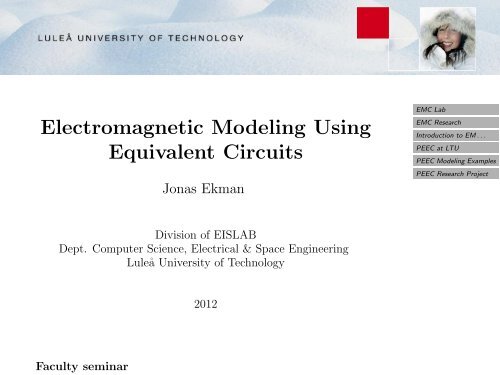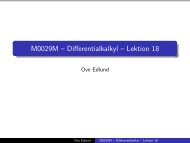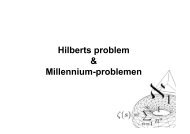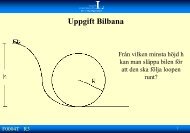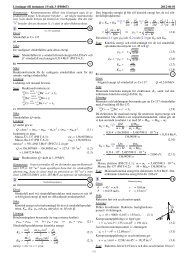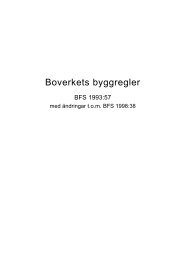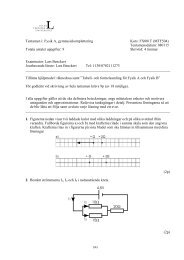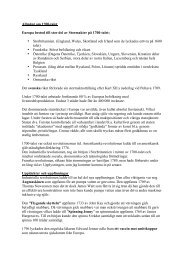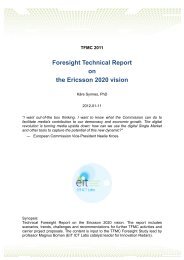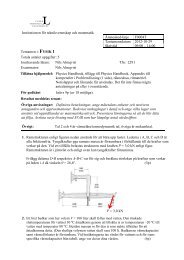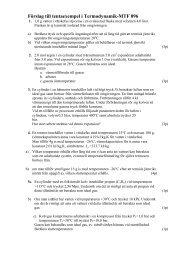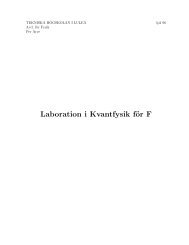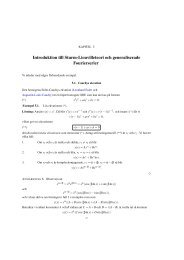Electromagnetic Modeling Using Equivalent Circuits
Electromagnetic Modeling Using Equivalent Circuits
Electromagnetic Modeling Using Equivalent Circuits
Create successful ePaper yourself
Turn your PDF publications into a flip-book with our unique Google optimized e-Paper software.
<strong>Electromagnetic</strong> <strong>Modeling</strong> <strong>Using</strong><br />
<strong>Equivalent</strong> <strong>Circuits</strong><br />
Jonas Ekman<br />
Division of EISLAB<br />
Dept. Computer Science, Electrical & Space Engineering<br />
Lule˚a University of Technology<br />
Faculty seminar<br />
2012<br />
EMC Lab<br />
EMC Research<br />
Introduction to EM . . .<br />
PEEC at LTU<br />
PEEC <strong>Modeling</strong> Examples<br />
PEEC Research Project
1. EMC Lab<br />
Ask question during the talk!<br />
The EMC Lab at EISLAB has two main purposes: to serve as a research and<br />
teaching facility and as a resource for the electronic industry in the region.<br />
Research is performed on electromagnetic simulations using the PEEC (Partial<br />
Element <strong>Equivalent</strong> Circuit).<br />
The EMC lab has a large, fully attenuated, electromagnetically shielded<br />
chamber. The chamber is equipped with antennas, transmission and receiving<br />
equipment covering the frequency range 30 MHz - 6 (best case) GHz.<br />
Examples of tests performed at the EMC Lab:<br />
• Emission and immunity testing, both conducted and radiated.<br />
• Transient testing (ESD, EFT, surge, burst).<br />
• Network analyzers, digital oscillocopes etc.<br />
EMC Lab<br />
EMC Research<br />
Introduction to EM . . .<br />
PEEC at LTU<br />
PEEC <strong>Modeling</strong> Examples<br />
PEEC Research Project
EMC Lab, cont.<br />
We used to o↵er to following courses to undergraduate students:<br />
• High frequency electronic systems.<br />
• EMC Technology.<br />
• Antennas<br />
Driving licence course<br />
We have a basic (mandatory) EMC course for companies who wish to use our<br />
lab for (pre-compliance) testing.<br />
EMC Lab<br />
EMC Research<br />
Introduction to EM . . .<br />
PEEC at LTU<br />
PEEC <strong>Modeling</strong> Examples<br />
PEEC Research Project
2. EMC Research<br />
• Electric equivalent circuit-based electromagnetic modeling:<br />
– high performance/parallel computing,<br />
– hybrid methods, and<br />
– for power electronic systems,<br />
• Train-related research:<br />
– bearing currents and 1<br />
– grounding problems.<br />
1 Ekman and Wisten, ‘Experimental investigation of the current distribution in the couplings<br />
of moving trains”, IEEE Transactions on Power Delivery, 2009.<br />
EMC Lab<br />
EMC Research<br />
Introduction to EM . . .<br />
PEEC at LTU<br />
PEEC <strong>Modeling</strong> Examples<br />
PEEC Research Project
Faculty<br />
• Jonas Ekman<br />
• Jerker Delsing<br />
• ˚Ake Wisten<br />
• Andreas Nilsson<br />
PhD Students<br />
• Danesh Daroui<br />
• Sohrab Safavi<br />
EMC Lab<br />
EMC Research<br />
Introduction to EM . . .<br />
PEEC at LTU<br />
PEEC <strong>Modeling</strong> Examples<br />
PEEC Research Project
3. Introduction to EM modeling & PEEC<br />
• We are talking about electromagnetic (EM) modeling or computational<br />
electromagnetics (CEM).<br />
• CEM is used to:<br />
– predict high frequency behavior,<br />
– ensure functionality,<br />
– understand the performance or bottlenecks of electrical interconnects<br />
and packaging,<br />
– calculate EM fields,<br />
– develop design guidelines,<br />
• Several di↵erent methods: FDTD, FEM, MTL, TLM, MoM, FIT, PEEC.<br />
• Due to mathematical di↵erences, di↵erent methods are suitable for specific<br />
types of problems ) Use the right method for the right problem.<br />
• EISLAB is developing PEEC since it is an electric equivalent circuit approach<br />
and we can integrate that with other SPICE-type of work that is<br />
going on within the division.<br />
EMC Lab<br />
EMC Research<br />
Introduction to EM . . .<br />
PEEC at LTU<br />
PEEC <strong>Modeling</strong> Examples<br />
PEEC Research Project
3.1. The Partial Element <strong>Equivalent</strong> Circuit Method<br />
3.1.1. Basic theory<br />
The theoretical derivation starts from the expression of the total electric field<br />
in free space as<br />
~E T (~r, t) = ~ E i (~r, t)<br />
@ ~ A(~r, t)<br />
@t<br />
r (~r, t). (1)<br />
If the observation point, ~r, is on the surface of a conductor, the total electric<br />
field can be written as ~ E T = ~ J(~r,t) ,inwhich ~ J(~r, t) is the current density on<br />
a conductor. To transform into the electric field integral equation (EFIE), the<br />
definitions of the electromagnetic potentials, ~ A and are used.<br />
~A(~r, t) =<br />
(~r, t) =<br />
KX<br />
k=1<br />
KX<br />
Z<br />
µ<br />
1<br />
✏0<br />
k=1<br />
Z<br />
vk<br />
vk<br />
G(~r,~r0) ~ J(~r0,td)dvk<br />
G(~r,~r0)q(~r0,td)dvk<br />
Combining results in the well known electric field integral equation.<br />
(2)<br />
(3)<br />
EMC Lab<br />
EMC Research<br />
Introduction to EM . . .<br />
PEEC at LTU<br />
PEEC <strong>Modeling</strong> Examples<br />
PEEC Research Project
The EFIE to be solved<br />
~E i (~r, t) = ~ Z<br />
J(~r, t)<br />
+ µ<br />
Interpreting the EFIE as KVL<br />
v0<br />
G(~r,~r0) @ ~ J(~r0,td)<br />
dv0 +<br />
@t<br />
r<br />
Z<br />
G(~r,~r0)q(~r0,td)dv0 (4)<br />
✏0 v0<br />
It is possible to interpret each term in the above equation as KVL since<br />
This results in interpreting:<br />
• The first RHS term as Resistance,<br />
• The second RHS term as Partial inductance<br />
V = RI + sLpI + Q/C (5)<br />
• The third RHS term as Coe cient of potential<br />
EMC Lab<br />
EMC Research<br />
Introduction to EM . . .<br />
PEEC at LTU<br />
PEEC <strong>Modeling</strong> Examples<br />
PEEC Research Project
The resulting equivalent circuit for a thin wire<br />
Lpmm<br />
R mm<br />
<br />
C <br />
Figure 1: One way of visualizing the interpretation of the EFIE as a partial<br />
element equivalent circuit (quasi-static approximation).<br />
C <br />
EMC Lab<br />
EMC Research<br />
Introduction to EM . . .<br />
PEEC at LTU<br />
PEEC <strong>Modeling</strong> Examples<br />
PEEC Research Project
The resulting equivalent circuit for a thin wire (FW)<br />
Lpmm<br />
R mm<br />
I i<br />
<br />
I<br />
V<br />
<br />
C<br />
j<br />
IC L<br />
mm<br />
1<br />
Pii I i<br />
1<br />
P Pjj Figure 2: One way of visualizing the interpretation of the EFIE as a partial<br />
element equivalent circuit (full-wave = taking care of delays).<br />
j<br />
IP EMC Lab<br />
EMC Research<br />
Introduction to EM . . .<br />
PEEC at LTU<br />
PEEC <strong>Modeling</strong> Examples<br />
PEEC Research Project
3.2. Simple PEEC model for two wires in free space<br />
I i<br />
P<br />
I i<br />
P<br />
Lpmm<br />
R mm<br />
I i<br />
<br />
I<br />
V<br />
<br />
C<br />
j<br />
IC L<br />
mm<br />
1<br />
Pii I i<br />
1<br />
P Pjj (a)<br />
(b)<br />
j<br />
IP Lpmm<br />
R mm<br />
I i<br />
<br />
I<br />
V<br />
<br />
C<br />
j<br />
IC L<br />
mm<br />
1<br />
Pii I i<br />
1<br />
P Pjj Figure 3: PEEC model for two conducting wires (a) using controlled voltageand<br />
current- sources to account for the electromagnetic couplings (b).<br />
j<br />
IP EMC Lab<br />
EMC Research<br />
Introduction to EM . . .<br />
PEEC at LTU<br />
PEEC <strong>Modeling</strong> Examples<br />
PEEC Research Project
1<br />
I 2<br />
1<br />
P11 1<br />
Ip Lp22<br />
I 1<br />
1<br />
Ip a<br />
2 VL -+<br />
2<br />
1<br />
P22 Lp11<br />
2<br />
Ip I 3<br />
c<br />
(a)<br />
2<br />
Ip -+<br />
1<br />
VL (b)<br />
Figure 4: Nonorthogonal metal patch (a) and PEEC model (b).<br />
Lp33<br />
1<br />
P44 4<br />
4<br />
Ip I 4<br />
V 3<br />
L<br />
-+<br />
Lp44<br />
4<br />
Ip 4 VL -+<br />
3<br />
1<br />
P33 b<br />
3<br />
Ip 3<br />
Ip EMC Lab<br />
EMC Research<br />
Introduction to EM . . .<br />
PEEC at LTU<br />
PEEC <strong>Modeling</strong> Examples<br />
PEEC Research Project
C 11<br />
Lp22<br />
C 12<br />
a<br />
Lp11<br />
C 14<br />
C 22<br />
c<br />
(a)<br />
Lp33<br />
C 13<br />
C 24<br />
(b)<br />
Figure 5: Nonorthogonal metal patch (a) and QS-PEEC model (b).<br />
C 23<br />
C 44<br />
Lp44<br />
C 34<br />
b<br />
C 33<br />
EMC Lab<br />
EMC Research<br />
Introduction to EM . . .<br />
PEEC at LTU<br />
PEEC <strong>Modeling</strong> Examples<br />
PEEC Research Project
a<br />
c<br />
(a)<br />
Lp11 1 4 {Lp11value} C11 1 0 {C11value}<br />
Lp22 1 2 {Lp22value} C22 2 0 {C22value}<br />
Lp33 2 3 {Lp33value} C33 3 0 {C33value}<br />
Lp44 4 3 {Lp44value} C44 4 0 {C44value}<br />
q<br />
K13 Lp11 Lp33<br />
q<br />
K24 Lp22 Lp44<br />
{Lp13value} 2<br />
{Lp11value}{Lp33value}<br />
{Lp24value} 2<br />
{Lp22value}{Lp44value}<br />
(b)<br />
b<br />
C12 1 2 {C12value}<br />
C13 1 3 {C13value}<br />
C14 1 4 {C14value}<br />
C23 2 3 {C23value}<br />
C24 2 4 {C24value}<br />
C34 3 4 {C34value}<br />
Figure 6: Nonorthogonal metal patch (a) and SPICE .cir-file in (b).<br />
EMC Lab<br />
EMC Research<br />
Introduction to EM . . .<br />
PEEC at LTU<br />
PEEC <strong>Modeling</strong> Examples<br />
PEEC Research Project
3.3. Example of structure possible to study with the PEEC<br />
formulation - in SPICE!<br />
EMC Lab<br />
EMC Research<br />
Introduction to EM . . .<br />
PEEC at LTU<br />
PEEC <strong>Modeling</strong> Examples<br />
PEEC Research Project
3.4. Summary of approach<br />
• Pros:<br />
• Cons:<br />
+ Same time- and frequency- domain model.<br />
+ Direct inclusion of other SPICE circuit elements.<br />
+ Solvable with SPICE-like solvers.<br />
+ Engineering-type of approach.<br />
- Large number of partial elements (speed-up, approximations).<br />
• Current academic cooperation within CEM:<br />
2. Giulio Antonini, University of L’Aquila.<br />
3. Göran Engdahl, KTH.<br />
• Industry (current and past) cooperations with: ABB, Volvo, BMW, Bosch,..<br />
EMC Lab<br />
EMC Research<br />
Introduction to EM . . .<br />
PEEC at LTU<br />
PEEC <strong>Modeling</strong> Examples<br />
PEEC Research Project
4. PEEC at LTU<br />
4.1. History<br />
1999-2001<br />
Hand calculations + PSpice ) Matlab/Java-routines + PSpice.<br />
Lesson learned<br />
If you feel that you are stuck, stuck, stuck......get help or get out!<br />
2001-2004<br />
Cooperation with UAq. Start with C++ solver with Lp and P calculations<br />
from IBM. All-in-one (solve circuit equations=no PSpice).<br />
2004-2007<br />
New solver (PETSc). All-in-one (solve circuit equations=no PSpice). New<br />
solver (GMM++) + parallel-PEEC. All-in-one (solve circuit equations=no PSpice).<br />
Post-processing in Matlab. Pre-processing in various CAD-formats (Gerber).<br />
2008-<br />
GMM++ going to Intel MKL going to PARDISO and MUMPS and then...<br />
EMC Lab<br />
EMC Research<br />
Introduction to EM . . .<br />
PEEC at LTU<br />
PEEC <strong>Modeling</strong> Examples<br />
PEEC Research Project
2010-<br />
ABB developing an internal graphical user interface to our solver (now called<br />
MultiPEEC). Internal e↵orts on interfacing OrCAD.<br />
2012-<br />
Working on project funding!<br />
EMC Lab<br />
EMC Research<br />
Introduction to EM . . .<br />
PEEC at LTU<br />
PEEC <strong>Modeling</strong> Examples<br />
PEEC Research Project
4.2. Pushing and pitching for this work - response to funding<br />
application 2003<br />
Hej Jonas.<br />
Tack för svaret. Jag har funderat litet till och känner mig klar. Min bedömning<br />
är att metoden inte kan ge ett positivt bidrag till den industriella utvecklingen<br />
inom kraftsystem. Det finns andra mer tillförlitliga och hanterbara verktyg<br />
utvecklade. Motiv:<br />
• Figur 2 i din ansökan är en mycket enkel krets, som alla kretsberäkningsprogram<br />
klarar. Det g˚ar även enkelt att räkna för hand.....<br />
• ..<br />
Du hänvisar till att jag skall kontakta Georgios Demetriades för att f˚a veta<br />
ABBs intresse för PEEC. Det är närmast en parodi,för Georgios h˚aller just nu<br />
p˚a med ett modelleringsarbete för ett HVDC-system. När det gäller modellering<br />
har han specialistkunskap, och det arbetet g˚ar bra. Men det är vi som i<br />
slutändan avgör vilka verktyg vi kan hantera och lita p˚a. Vad jag vet är det<br />
inte s˚am˚anga andra inom ABB som räknar p˚a s˚adana här problem där f ältteori<br />
och kretsberäkning m˚aste kombineras. Sorry, för det här nedsl˚aende beskedet,<br />
men jag tror att Du i längden är mest betjänt av ett ärligt svar s˚a Du kan ägna<br />
Dina krafter ˚at n˚agot som har större potential att lyckas.<br />
Vänliga hälsningar, Lars-Erik Juhlin, Senior specialist HVDC system design<br />
EMC Lab<br />
EMC Research<br />
Introduction to EM . . .<br />
PEEC at LTU<br />
PEEC <strong>Modeling</strong> Examples<br />
PEEC Research Project
Lesson learned<br />
Do not listen to anyone, especially not a specialist, if you know that you<br />
are right!<br />
EMC Lab<br />
EMC Research<br />
Introduction to EM . . .<br />
PEEC at LTU<br />
PEEC <strong>Modeling</strong> Examples<br />
PEEC Research Project
5. PEEC <strong>Modeling</strong> Examples<br />
5.1. Inductance calculations<br />
1 ⇥ 1 m sq. free-space rectangular loop made of thin wire.<br />
1. Analytical approach: The inductance is given by<br />
Lanalytic =0.4((a+b)ln( 4ab<br />
) a ln(a+g) b ln(b+g))+0.4(2g+d 2(a+b)), (6)<br />
d<br />
where a and b are the length and the width of the loop, d is the wire diameter,<br />
and g is the rectangle loop diagonal. With the following data: a = b = 1,<br />
d =0.005, and g = p 2 the loop inductance is Lanalytic = 4.17 µH.<br />
EMC Lab<br />
EMC Research<br />
Introduction to EM . . .<br />
PEEC at LTU<br />
PEEC <strong>Modeling</strong> Examples<br />
PEEC Research Project
PEEC approach.<br />
2. You model the 1 ⇥ 1 m sq. free-space rectangular loop made of thin wire.<br />
You get the partial inductance matrix,<br />
2<br />
6<br />
Lp = 6<br />
4<br />
1.14<br />
0<br />
0.11<br />
0<br />
1.14<br />
0<br />
0.11<br />
0<br />
1.14<br />
0<br />
0.11<br />
0<br />
0 0.11 0 1.14<br />
And then calculate the loop inductance.<br />
3<br />
7<br />
5 µH. (7)<br />
3. Or, you run your PEEC model with only partial inductances and resistance<br />
and extract the inductance.<br />
But, really! Inductance calculations?! Is that so important?<br />
EMC Lab<br />
EMC Research<br />
Introduction to EM . . .<br />
PEEC at LTU<br />
PEEC <strong>Modeling</strong> Examples<br />
PEEC Research Project
5.2. Automotive chassis<br />
• Nonorthogonal PEEC<br />
• 2 862 surfaces and 3 816 volumes<br />
• Front bumper is excited using a 1 V,<br />
Gaussian pulse with ’rise time’ 50 ns.<br />
• The front bumper grounded by a 100 ⌦<br />
resistor. Back bumper grounded by a<br />
50 ⌦ resistor.<br />
• FW, TD analysis, 200 points: 4 h, 10 m.<br />
• FW, FD analysis: 50 freqs.: 5 h.<br />
• Regular Linux server with 4 Gb Ram<br />
• Code by LTU, UAq, and IBM.<br />
EMC Lab<br />
EMC Research<br />
Introduction to EM . . .<br />
PEEC at LTU<br />
PEEC <strong>Modeling</strong> Examples<br />
PEEC Research Project
Animations from transient analysis<br />
Current distribution shown with arrows.<br />
Figure 7: Screenshot from 50 ns for current source excitation at the front<br />
EMC Lab<br />
EMC Research<br />
Introduction to EM . . .<br />
PEEC at LTU<br />
PEEC <strong>Modeling</strong> Examples<br />
PEEC Research Project
5.3. Aperture in groundplane<br />
A bent conductor over a groundplane with an aperture.<br />
• Orthogonal PEEC<br />
• 724 surfaces and 1 244 volumes<br />
• Near-end di↵erentially excited with 1 A,<br />
Gaussian pulse with ’rise time’ 1 ns.<br />
• Far-end grounded by 50 ⌦<br />
resistor.<br />
• FW, TD analysis, 200 points: 4 h, 10 m.<br />
• FW, FD analysis: 250 freqs.: 5 h.<br />
• Regular Linux server with 4 Gb Ram<br />
• Code by LTU, UAq, and IBM.<br />
EMC Lab<br />
EMC Research<br />
Introduction to EM . . .<br />
PEEC at LTU<br />
PEEC <strong>Modeling</strong> Examples<br />
PEEC Research Project
5.4. Metallic case<br />
A 19x43x38 cm (LxWxT) case with one opening (19x10) in the front is modeled<br />
in the time- and frequency domain.<br />
• Orthogonal PEEC<br />
• 1 470 surfaces and 2 703 volumes<br />
• Front excited with 1 A,<br />
pulse with rise time 1 ns.<br />
• Case grounded at 2 locations.<br />
• FW, TD analysis, 250 points: ⇠ 1m<br />
• FW, FD analysis: 200 freqs.: 30 mins.<br />
• Regular Linux server with 4 Gb Ram<br />
• Code by LTU, UAq, and IBM.<br />
EMC Lab<br />
EMC Research<br />
Introduction to EM . . .<br />
PEEC at LTU<br />
PEEC <strong>Modeling</strong> Examples<br />
PEEC Research Project
5.5. Reactor<br />
Z<br />
70<br />
60<br />
50<br />
40<br />
30<br />
20<br />
10<br />
0<br />
50<br />
40<br />
30<br />
Y<br />
20<br />
10<br />
0<br />
20<br />
X<br />
40<br />
• 1.8 m high free-space reactor,<br />
1 m sides<br />
• Orthogonal PEEC<br />
• 1 200 surfaces and 800 volumes<br />
• Near-ends excited with 1 A,<br />
’Gaussian’ pulse with di↵erent rise times.<br />
• Near and far-ends grounded.<br />
• QS, TD analysis, 300 points: ⇠ 50 s.<br />
• Regular Linux server with 4 Gb Ram<br />
• Code by LTU, UAq, and IBM.<br />
EMC Lab<br />
EMC Research<br />
Introduction to EM . . .<br />
PEEC at LTU<br />
PEEC <strong>Modeling</strong> Examples<br />
PEEC Research Project
6. PEEC Research Project<br />
6.1. Reactor PEEC <strong>Modeling</strong><br />
Project goals are to (1) use PEEC to construct high frequency (up to 10 MHz)<br />
models for reactors, (2) synthesize into (reduced) equivalent circuits, and (3)<br />
exported to SPICE-like solvers for use in system studies 2<br />
Funded by: Elforsk/ELEKTRA<br />
Industry partners: ABB, Banverket, STRI<br />
Period: May 2005 to Dec. 2007<br />
Contact: Dr. Jonas Ekman<br />
PhD Student: Mathias Enohnyaket<br />
2 Enohnyaket & Ekman, ‘Analysis of air-core reactors from DC to very high frequencies<br />
using PEEC modelss”, IEEE Transactions on Power Deliveryy, 2009<br />
EMC Lab<br />
EMC Research<br />
Introduction to EM . . .<br />
PEEC at LTU<br />
PEEC <strong>Modeling</strong> Examples<br />
PEEC Research Project
6.2. PEEC-modeling of RFID system with moving transponders<br />
Show a simulation environment which enables description of a complete RFID<br />
system including moving and rotating transponders as well as a complex, industrial<br />
environment 3 .<br />
Funded by: ProocessIT Innovations<br />
Period: 2008 to 2009<br />
Industrial partner: Electrotech<br />
PhD student: Tore Lindgren<br />
3 Lindgren, Kvarnström, & Ekman, “Monte Carlo simulation of an radio frequency identification<br />
system with moving transponders using the partial element equivalent circuit method”,<br />
IET Microwaves Antennas & Propagation, 2010<br />
EMC Lab<br />
EMC Research<br />
Introduction to EM . . .<br />
PEEC at LTU<br />
PEEC <strong>Modeling</strong> Examples<br />
PEEC Research Project
6.3. EM modeling for automotive applications<br />
Project goals are to develop PEEC for combined analysis of:<br />
• chassis and multi-conductor transmission lines,<br />
• chassis and antennas‘ 4 .<br />
Funded by: CASTT<br />
Period: May 2006 to Dec. 2008<br />
Contact: Dr. Jonas Ekman<br />
Student: Peter Anttu<br />
4 Antonini, Miscione, & Ekman, “PEEC modeling of automotive electromagnetic problems”,<br />
Applied Computational <strong>Electromagnetic</strong>s Society Newsletter, 2008.<br />
EMC Lab<br />
EMC Research<br />
Introduction to EM . . .<br />
PEEC at LTU<br />
PEEC <strong>Modeling</strong> Examples<br />
PEEC Research Project
6.4. PEEC for power electronic systems analysis<br />
Project goals to enable realistic PEEC-modeling of PES 5 . For example:<br />
• inductance calculations, resistance calculations,<br />
• impedance matrix extraction, field calculations, acceleration, robustness<br />
Funded by: ABB/Elforsk<br />
Industry partners: ABB, Switzerland<br />
Period: 2008 to 2013<br />
PhD Student: Danesh Daroui<br />
5 Daroui & Ekman, “E cient PEEC-based simulations using reluctance method for power<br />
electronic applications”, Applied Computational <strong>Electromagnetic</strong>s Society Journal, 2012.<br />
!<br />
EMC Lab<br />
EMC Research<br />
Introduction to EM . . .<br />
PEEC at LTU<br />
PEEC <strong>Modeling</strong> Examples<br />
PEEC Research Project
6.5. PEEC and SPICE Solution<br />
Project goals to enable realistic PEEC-modeling and complex additional circuitry<br />
analysis - All-in-one!: Full PEEC model and Full SPICE/OrCAD-solver 6 .<br />
0<br />
Vpos<br />
15Vdc<br />
0<br />
0<br />
Q1<br />
V1<br />
VOFF = 0<br />
VAMPL = 5u<br />
FREQ = 1G<br />
Vneg<br />
15Vdc Q9<br />
R1<br />
28.6k<br />
R2<br />
20k<br />
Q3<br />
Q2<br />
R3<br />
20k<br />
Q4<br />
Q12<br />
Q11<br />
R4<br />
5k<br />
Q5<br />
Q10<br />
Q6<br />
R5<br />
2.3k<br />
Q7<br />
R7<br />
12.47k<br />
Q8<br />
C1<br />
1n<br />
R8<br />
3k<br />
Funded by: ESIS<br />
Period: 2010 to 2013<br />
PhD Student: Sohrab Safavi<br />
V<br />
0<br />
T1<br />
in1 out1<br />
in2 out2<br />
T2coupled<br />
6 Safavi & Ekman, “Feasibility analysis of specialized PEEC solvers in comparison to<br />
SPICE-like solvers”, Journal of Computational Electronics, 2012<br />
0<br />
V<br />
R9<br />
50<br />
0<br />
C2<br />
1p<br />
EMC Lab<br />
EMC Research<br />
Introduction to EM . . .<br />
PEEC at LTU<br />
PEEC <strong>Modeling</strong> Examples<br />
PEEC Research Project
6.6. Future<br />
PEEC Road map 7 :<br />
• Magnetic material handling.<br />
• Full SPICE/OrCAD-solver.<br />
• Meshing / discretization of complex structures.<br />
7 Antonini, Delsing, Ekman, Orlandi and Ruehli, “PEEC development road map”, working<br />
paper. 2009<br />
EMC Lab<br />
EMC Research<br />
Introduction to EM . . .<br />
PEEC at LTU<br />
PEEC <strong>Modeling</strong> Examples<br />
PEEC Research Project
END<br />
Thank You!<br />
EMC Lab<br />
EMC Research<br />
Introduction to EM . . .<br />
PEEC at LTU<br />
PEEC <strong>Modeling</strong> Examples<br />
PEEC Research Project


